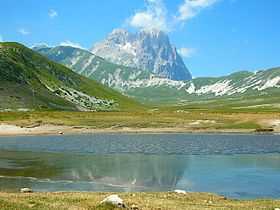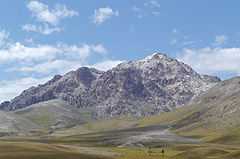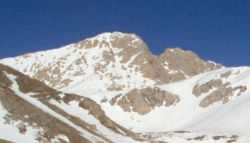Gran Sasso d'Italia
| Gran Sasso d'Italia | |
|---|---|
 Gran Sasso mountain, the highest peak in the Apennines | |
| Elevation | 2,912 m (9,554 ft) |
| Location | |
 Gran Sasso d'Italia | |
| Range | Apennines |
| Coordinates | 42°28′N 13°33′E / 42.467°N 13.550°ECoordinates: 42°28′N 13°33′E / 42.467°N 13.550°E |


Gran Sasso d'Italia is a mountain located in the Abruzzo region of central Italy. The Gran Sasso forms the centrepiece of the Gran Sasso e Monti della Laga National Park which was established in 1993 and holds the highest mountains in continental Italy south of the Alps and is part of the Apennines, the mountain range that runs the entire length of the Italian Peninsula. Teramo and L'Aquila are the nearest cities to the Gran Sasso, while Assergi, at the base of the mountain, is the nearest village; Rome is 132 kilometres (82 mi) by road.
Geography
The three main summits of the Gran Sasso are Corno Grande (shown here), which at 2,912 metres is the highest peak in the Apennines, nearby Corno Piccolo and Pizzo Intermesoli, which is separated from the other two peaks by Val Maone, a deep valley. Corno Grande and Corno Piccolo's ash coloration come from their limestone and dolomite composition. The peaks are snow-covered for much of the year though the snow cover appears to be less each decade. Corno Piccolo is referred to as, "The Sleeping Giant". This is due to the appearance of a profile of a reclined face. This view of Corno Piccolo is evident when viewing the mountain from Pietracamela, a small town near Prati di Tivo, on the north side of the mountain. Corno Grande and Corno Piccolo with their rough vertical walls provide serious rock climbers some of the best climbing in Europe.
Situated below the peak of the Corno Grande is the Calderone glacier, until 2009 the southernmost known glacier in Europe; deglaciation has significantly reduced the glacier's size. Glaciologists now question whether the glacier will survive past 2020.
The mid- to lower slopes of the Gran Sasso are grazed in spring, summer and autumn by large flocks of sheep guarded by Maremmano-Abruzzese sheepdogs as well as herds of cattle and semi-wild horses. The pastures are covered with field grasses and meadowland wildflowers. The park is also the habitat for diverse wildlife from rare species such as the Apennine wolf, the Marsican bear, wildcat and the Abruzzo chamois (Rupicapra pyrenaica ornata), a variety of chamois at the very edge of extinction but now making a comeback in the park through a joint effort by WWF Italia and the park administration. Other species of wildlife include wild boar, foxes, grass snakes such as Orsini's viper, and a wide variety of bird life including golden eagles, peregrine falcons, goshawks, Ortolan buntings, rock sparrows, crested larks, red-backed shrikes and downy pipits.
At the northern base of Corno Piccolo is Prati di Tivo, a ski village. To the east of Corno Grande and Corno Piccolo is Campo Imperatore, a 27 km long and 8 km wide high plain or plateau at about 2000 m height. Campo Imperatore is home to Italy's oldest continuously operating commercial ski area (is connected to Fonte Cerreto by a big lift).
History
A hotel midway on the top of Campo Imperatore is where the Italian fascist dictator Benito Mussolini was imprisoned from August until September 1943 when he was freed by a Nazi commando operation. The plateau is also the site of the Campo Imperatore station of the Rome Observatory, from which the Campo Imperatore Near-Earth Object Survey and other astronomical studies are carried out. At the southern edge of Campo Imperatore and within the bounds of the national park are three medieval hill towns once ruled by the Medicis: Calascio, which sits before the ancient fortress ruin of Rocca di Calascio, and Santo Stefano di Sessanio and Castel Del Monte.

The name Gran Sasso means "Great Stone".
In 2005, a 2424 m (7953 ft) peak previously named "The Gendarme" was renamed "John Paul II Peak" on what would have been Pope John Paul II's 85th birthday.[1] He had visited the Gran Sasso many times, saying it reminded him of the mountains of his native Poland.
Science
In 1984, a 10 km two-lane highway tunnel carrying the A24 autostrade, the Traforo del Gran Sasso, was bored through the Gran Sasso Massif. In 1995, a second parallel tunnel was completed. Construction of the tunnel included an underground particle physics laboratory at Assergi, the Laboratori Nazionali del Gran Sasso or Gran Sasso National Laboratory. The first large experiments there started in 1989.
The laboratory is composed of three large underground chambers, sometimes referred to collectively as the third tunnel and lies beneath 1400 metres of rock. Construction of the laboratory and second tunnel faced fierce opposition from Italian and international environmental groups including Pro Natura, LIPU and Club Alpino Italiano as well as the World Wildlife Federation and WWF Italia, Greenpeace and Friends of the Earth. Environmentalists noted that the nuclear physics laboratory would lie on or near two major and highly active seismic faults, that construction of the tunnels would interfere with a major aquifer, and that construction waste would degrade an environmentally sensitive and significant area. The underground laboratory, which opened in 1989, with its low background radiation is used for experiments in particle and nuclear physics, including the study of neutrinos, high-energy cosmic rays, dark matter, nuclear decay, as well as geology, and biology. The laboratory employs over 700 scientists from twenty different countries. Many credit the opposition created by the tunnel and laboratory construction with galvanizing the Italian environmental movement and leading to the very creation of the Parco Nazionale del Gran Sasso in 1991. In recent years, the laboratory has itself begun promoting preservation of the Gran Sasso environment.
The LNGS was the destination of the neutrinos involved in the faster-than-light neutrino anomaly publicly announced in September 2011.
Tourism
The Gran Sasso is located in the Gran Sasso e Monti della Laga National Park. Running through this nature preserve is a portion of the Italian State Highway 80 (SS80), known as the Grand Highway of the Gran Sasso and Monti della Laga National Park ("Strada maestra del Parco").
While frequented by skiers in winter, and mountain climbers and hikers in other seasons, the Gran Sasso is remarkably free of tourists despite its proximity to Rome and the events of the Gran Sasso raid that took place there in 1943. This is especially true in summer with most Italians preferring beach vacations and foreign visitors more likely to visit the mountains of northern Italy.
Points of interest
| Wikimedia Commons has media related to Gran Sasso. |
References
- ↑ "Peak is named after late pontiff". BBC News. 2005-05-18.
External links
- Inside Abruzzo: Insider Tips Uncovered
- The National Park of the Gran Sasso
- "Parco Nazionale del Gran Sasso e Monti della Laga".
- "Images from Gran Sasso d'Italia, news and webcam".
- ""The Big Stone", climbing in the Gran Sasso (translated from French)".
- "Sciaplinismo negli Appenni (article in Italian on "scialpinismo", combined mountain climbing and skiing) on the Gran Sasso".
- "Laboratori Nazionali del Gran Sasso website".